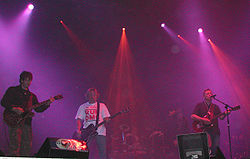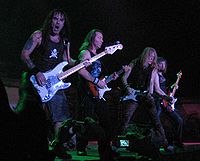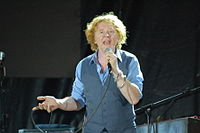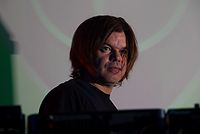- Music of the United Kingdom (1980s)
-
This article is about British popular music of the 1980s. For Classical music, see Classical music of the United Kingdom.
1980s in music in the UK Number-one singles Number-one albums Best-selling singles Best-selling albums Summaries and charts
1980, 1981, 1982, 1983, 1984
1985, 1986, 1987, 1988, 1989←1979 1990→ Top 10 singles
1980, 1981, 1982, 1983, 1984
1985, 1986, 1987, 1988, 1989←1979 1990→ Popular music of the United Kingdom in the 1980s built on the post punk and new wave movements, incorporating different sources of inspiration from sub-genres and what is now classed as World music in the shape of Jamaican and Indian music. It also explored the consequences of new technology and social change in the electronic music of synth pop. In the early years of the decade, while sub-genres like heavy metal music continued to develop separately, there was a considerable crossover between rock and more commercial popular music, with a large number of more "serious" bands, like The Police and UB40, enjoying considerable single chart success. The advent of MTV and cable video helped spur what has been seen as a Second British Invasion in the early years of the decade, with British bands enjoying more success in America than they had since the height of the Beatles' popularity in the 1960s. However, by the end of the decade a fragmentation has been observed, with many new forms of music and sub-cultures, including Hip Hop and House music, while the single charts were once again dominated by pop artists, now often associated with the Hi-NRG hit factory of Stock Aitken Waterman. The rise of the Indie rock scene was partly a response to this, and marked a shift away from the major music labels and towards the importance of local scenes like Madchester and sub-genres, like gothic rock.[1]
Contents
Rock
New romantics
Main article: New Romanticism Duran Duran on stage in 2005.
Duran Duran on stage in 2005.
New Romanticism emerged in London nightclubs including Billy's and The Blitz Club towards the end of the 1970s. Influenced by David Bowie and Roxy Music, it developed glam rock fashions, gaining its name from the frilly fop shirts of early Romanticism. New Romantic music often made extensive use of synthesisers. Pioneers included Visage and Ultravox and among the commercially most successful acts associated with the movement were Adam and the Ants, Culture Club, Spandau Ballet and Duran Duran.[2] By about 1983 the original movement had dissolved, with surviving acts dropping most of the fashion elements to pursue mainstream careers.
Post punk
Main article: Post punkSome of the most successful post punk bands in the 1970s, such as Siouxsie and the Banshees and The Psychedelic Furs, also continued their success during the 1980s. Members of Bauhaus and Joy Division explored new stylistic territory as Love and Rockets and New Order respectively.[3] The second generation of British post-punk bands that broke through in the early 1980s, including The Fall, The Pop Group, The Mekons, Echo and the Bunnymen and Teardrop Explodes, tended to move away from dark sonic landscapes.[3] Some, such as Gang of Four, shifted to a more commercial New Wave sound,[4][5] while others moved into Gothic rock[6] or became early examples of indie rock.[7]
Gothic rock
Main article: Gothic rock The Cure on stage in 2008.
The Cure on stage in 2008.
Gothic rock, often shortened to goth, developed out of the post punk scene in the early 1980s. It combines dark, often keyboard-heavy music with introspective and depressing lyrics. Notable early gothic rock bands include Bauhaus (whose "Bela Lugosi's Dead" is often cited as the first goth record), Siouxsie and the Banshees (who may have coined the term), The Cure, The Sisters of Mercy, and Fields of the Nephilim.[6] Gothic rock gave rise to a broader goth subculture that included clubs, various fashion trends and numerous publications that grew in popularity in the 1980s, gaining notoriety by being associated by several moral panics over suicide and Satanism.[8]
Indie rock
Main articles: Indie rock and Alternative rockIndie or independent rock(often described as alternative rock in the U.S.), was a scene that emerged out of post punk and new wave eschewing the major record labels for control of their own music and relying on local scenes or national sub-cultures to provide an audience. Having enjoyed some success a number of indie acts were able to move into the mainstream, including early indie bands Aztec Camera, Orange Juice and The Smiths, followed by The Housemartins and James. The C86 cassette, released in 1986 by NME and featuring such bands as The Wedding Present, Primal Scream, The Pastels, and the Soup Dragons, was a major influence on the development of indie pop and the British indie scene as a whole.[9][10] Other forms of alternative rock developed in the UK during the 1980s. The Jesus and Mary Chain wrapped their pop melodies in walls of guitar noise, while New Order emerged from the demise of post-punk band Joy Division and experimented with techno and house music, forging the alternative dance style. The Mary Chain, along with Dinosaur Jr and the dream pop of Cocteau Twins, were the influences for the shoegazing movement of the late 1980s. Named for the bandmembers' tendency to stare at their feet onstage, shoegazing acts like My Bloody Valentine, Slowdive, Ride, and Lush created an overwhelmingly loud "wash of sound" that obscured vocals and melodies with long, droning riffs, distortion, and feedback.[11] Shoegazing bands dominated the British music press at the end of the decade along with the drug-fueled Madchester scene. Based around The Haçienda, a nightclub in Manchester owned by New Order and Factory Records, Madchester bands such as The Stone Roses and the Happy Mondays mixed acid house dance rhythms with melodic guitar pop.[12]
Heavy metal
Main article: Heavy metal musicIn the 1980s, the New Wave of British Heavy Metal broke into the mainstream, as albums by Judas Priest, Iron Maiden, Saxon and Motörhead, reached the British top 10. In 1981, Motörhead became the first of this new breed of metal bands to top the UK charts with No Sleep 'til Hammersmith. Many metal artists, including Def Leppard, benefited from the exposure they received on MTV and became the inspiration for American Glam Metal.[13] However, as the sub-genre fragmented, much of the creative impetus moved away from Britain to American and continental Europe (particularly Germany and Scandinavia), which produced most of the major new sub-genres of metal, which were then taken up by British acts. These included thrash metal and death metal, both developed in the USA; black metal and power metal, both developed in continental Europe, but influenced by the British band Venom; and doom, which was developed in the USA, but which soon were adopted by a number of bands from England, including Pagan Altar and Witchfinder General.[14]
Grindcore
Main article: GrindcoreGrindcore, or simply grind, emerged during the mid–1980s as an extreme music genre characterized by heavily distorted, down-tuned guitars, high speed tempo, blast beats, songs often lasting no more than two minutes (some are seconds long), and vocals which consist of growls and high-pitched screams. It drew inspiration from some of the most abrasive music genres – including death metal, industrial music, noise and the more extreme varieties of hardcore punk. Grindcore, as such, was developed during the mid-1980s in the United Kingdom by Napalm Death, a group who emerged from the crust punk scene.[15] Napalm Death inspired other British grindcore groups in the 1980s, among them Extreme Noise Terror,[15] Carcass and Sore Throat.[16]
Folk punk
Main article: Folk punk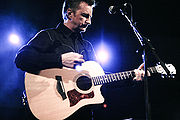 Billy Bragg performing at South by Southwest in 2008.
Billy Bragg performing at South by Southwest in 2008.
Folk punk or rogue folk is a fusion of folk music and punk rock, or occasionally other genres, which was pioneered by the London-based Irish band The Pogues in the 1980s. It achieved some mainstream success in the 1980s and, particularly as the sub-genre of Celtic punk, has been widely adopted in areas of the Celtic diaspora in North America and Australia and by many bands in continental central and eastern Europe. Unlike earlier Celtic rock and electric folk groups, folk punk groups tend to include relatively little traditional music in their repertoire, but instead usually performed their own compositions, often following the form of punk rock, using additional folk instrumentation, including, mandolin, accordion, banjo and particularly violin.[17] Other bands adopted some traditional forms of music, including sea shanties and eastern European gypsy music. Among the most successful performers were The Levellers,[17] and singer-songwriter Billy Bragg, who enjoyed a series of hits in the 1980s.[18]
Pop
Main article: Pop musicThe British charts at the opening of the 1980s contained the usual mix of imports, novelty acts, oddities (including rock 'n' roll revivalist Shakin' Stevens) and survivors like Queen and David Bowie, but were dominated by post punk, and then from about 1981 by new romantic acts. There were also more conventional pop acts, including Bucks Fizz, whose light lyrics and simple tempos gave them three number ones after their Eurovision Song Contest victory in 1981.[19] The dance pop music of Frankie goes to Hollywood, initially controversial, gave them three consecutive number ones in 1984, until they faded away in the mid-1980s.[19] Probably the most successful British pop band of the era were the duo Wham! with an unusual mix of disco, soul, ballads and even rap, who had eleven top ten hits in the UK, six of them number ones, between 1982 and 1986.[19] In the second half of the 1980s British pop music was dominated by Stock Aitken Waterman's "hit factory" with the uniformity of their Hi-NRG sound.[20]
Synth pop
Main article: Synth popSynth pop emerged from New Wave, producing a form of pop music that followed electronic rock pioneers in the 1960s and 1970s like Kraftwerk, Jean Michel Jarre, and Tangerine Dream, in which the synthesizer is the dominant musical instrument.[21] Tubeway Army a little known outfit from West London, dropped their punk rock image and topped the UK charts in 1979 with the single "Are Friends Electric?", prompting their singer, Gary Numan to go solo and release the album, The Pleasure Principle from which he gained a number one in the single charts with "Cars".[21] Trevor Horn of The Buggles captured the changing scene in the international hit Video Killed the Radio Star. It also became dominant for many new romantic acts like Visage, Ultravox, Duran Duran and Japan.[21] There were also more straight forwardly pop acts like The Human League as well as Depeche Mode, Soft Cell, and Yazoo. Other key artists from the early-mid 1980s include Eurythmics, Talk Talk, A Flock of Seagulls, Tears for Fears, New Order, Pet Shop Boys, OMD, Thomas Dolby, Thompson Twins, Bronski Beat, Heaven 17, Howard Jones and Blancmange.[21]
Hi-NRG
Main article: Hi-NRG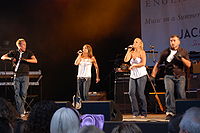 The reformed Bananarama on stage in 2007.
The reformed Bananarama on stage in 2007.
Hi-NRG (High Energy) is high-tempo disco music (often with electronic instrumentation), as well as a more specific, derivative genre of electronic dance music that achieved mainstream popularity in the mid to late 1980s. In the early 1980s hi energy disco had become popular in the gay scene of American cities like New York and San Francisco with acts like Divine, and The Weather Girls.[22] In 1983 in the UK, music magazine Record Mirror championed the gay underground sound and began publishing a weekly Hi-NRG Chart.[23] Hi-NRG also entered the mainstream with hits in the UK pop charts, such as Hazell Dean's "Searchin' (I Gotta Find a Man)" and Evelyn Thomas's "High Energy".[24][25] In the mid-1980s, Hi-NRG producers in the dance and pop charts included Ian Levine and trio Stock Aitken Waterman, both of whom worked with many different artists. Stock Aitken Waterman had three of the most successful Hi-NRG singles ever with their productions of Dead or Alive's "You Spin Me Round (Like a Record)" (UK #1 & US #11 in 1985), Bananarama's "Venus" (US #1 & UK #8 in 1986), and Rick Astley's "Never Gonna Give You Up" (UK #1 & US #1 in 1987). Their artists dominated British pop music and the charts in the late 1980s, including Bananarama, Rick Astley and Australian actress Kylie Minogue.[26]
Soul
Main article: British soulBritain had produced some significant Blue-eyed soul singers in the 1960s, including Tom Jones and Dusty Springfield and interest had been maintained by figures such as David Bowie, but it was not until the 1980s that a clear genre of British soul music developed with flourishing soul scenes in major cities like London and Manchester, often with many black artists, supported by local and pirate radio stations.[27] This interest was reflected in a series of covers or songs inspired by soul for a number of major acts, including Phil Collins's "You Can't Hurry Love" (1982), Culture Club's "Church of the Poison Mind" (1983), The Style Council's "Speak Like a Child", (1983) Eurythmics' "Missionary Man" (1986), and Steve Winwood "Roll With It" (1998).[28] For the first time since the 1960s there were also significant acts who specialised in soul. These included George Michael, who reinvented himself a white soul singer with the multi-Platinum Faith album (1987).[28] Also significant were Sade, Simply Red and toward the end of the decade Lisa Stansfield and Soul II Soul.[28] Soul II Soul's breakthrough R&B hits "Keep on Movin'" and "Back to Life" in 1989 have been seen as opening the door to the mainstream for black British soul and R&B performers.[28]
Hip hop
Main article: British hip hop Tim Westwood one of the most important DJs to promote hip hop in Britain.
Tim Westwood one of the most important DJs to promote hip hop in Britain.
A British hip hop scene emerged in the early 1980s, largely based on American hip hop music at parties and club nights,[29] In this period some pop records dabbled with rap - such as Adam and the Ants' "Ant Rap" (1981) LP, Wham's "Wham Rap (Enjoy What You Do)" (1982) and Malcolm McLaren's "Buffalo Gals" (1982). More serious British artists were rapping live or recording amateur tapes in the early 1980s, but the first British hip hop tune released on record was "London Bridge" by Newtrament in 1984.[30] Over the next few years, more UK hip hop and electro was released: Street Sounds Electro UK (1984), which was produced by Greg Wilson and featured an early appearance from MC Kermit, who later went on to form the Wilson produced Ruthless Rap Assassins; The Rapologists' "Kids Rap/Party Rap" (1984), but releases and national publicity were still rare. Mainstream radio did play British hip hop on occasion, and instrumental in giving the scene wider recognition were DJs such as Dave Pearce, Tim Westwood, and John Peel, but in this period it made very little impact on the mainstream charts. The scene remained predominantly underground depending on word of mouth and the patronage of pirate radio stations. The first UK record label devoted to releasing UK hip hop acts Simon Harris' Music of Life label was founded in 1986. It was home to Derek B, the first UK rapper to achieve chart success. Music of Life went on to sign groups such as Hijack, the Demon Boyz, Hardnoise (later Son of Noise) and MC Duke. Other acts and styles developed from the hip hop scene, resulting in new genres to describe them - for example Massive Attack[31] with trip hop, or Galliano with Acid Jazz. Hip Hop Connection, the first major British hip hop magazine, was founded in 1989 and by the early 1990s the British hip hop scene seemed to be thriving. Not only was there a firm base of rappers in London - such as Blade, Black Radical Mk II and Overlord X - but many distinct scenes developed nationally.
Electronic music
In the 1980s, dance music records made using only electronic instruments became increasingly popular, largely influenced from the Electronic music of Kraftwerk and disco music. Such music was originally born of and popularized via regional nightclub scenes in the 1980s, and became the predominant type of music played in discothèques as well as the rave scene.
House music
Main article: House musicHouse music was a style of electronic dance music that originated in Chicago, Illinois, USA in the early 1980s.[32] House music was strongly influenced by elements of soul- and funk-infused varieties of disco. House music generally mimics disco's percussion, especially the use of a prominent bass drum on every beat, but may feature a prominent synthesizer bassline, electronic drums, electronic effects, funk and pop samples, and reverb- or delay-enhanced vocals. In the early 1980s a UK house scene developed in cities such as London, Birmingham and Manchester, particularly at the The Haçienda Club and on the holiday island of Ibiza.[33] One of the earliest and most influential UK house and techno record labels was Network Records (otherwise known as Kool Kat records) who helped introduce Italian and U.S. dance music to Britain as well as promoting select UK dance music acts. The first English House tune "Carino" by T-Coy was released in 1986.[34] By late 1987 DJs like Paul Oakenfold and Danny Rampling were bringing the Ibiza sound to UK clubs like Shoom in Southwark (London), Heaven, Future, Spectrum and Purple Raines in Birmingham.[35]
Jazz
Main article: British jazz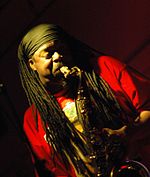 Courtney Pine performing in 2006.
Courtney Pine performing in 2006.
After the lean years of the 1970s there was something of a British Jazz revival based in London's Soho in the 1980s.[36] Initially this UK jazz dance scene was led by DJs like Paul Murphy, but it soon expanded to support live bands and to start its own record labels.[36] The revival was marked by the appearance of a new generation of Black British musicians, including members of the influential groups Loose Tubes (formed 1983): Django Bates, Iain Ballamy and Julian Argüelles and Jazz Warriors (formed 1986): Courtney Pine, Gary Crosby, Julian Joseph, and later Soweto Kinch and Jason Yarde.[37] The Acid Jazz label was formed in 1987, producing a mix of hip hop and funk beat flavoured jazz stylings that put traditional jazz elements over modern beats.[36]
2 Tone and Reggae
Main article: 2 ToneHaving emerged out of the post punk and reggae scenes in the West Midlands in the 1970s, the ska revival associated with 2 Tone records was a remarkable commercial success in the early years of the 1980s. Bands like The Specials, The Selecter, The Beat, Madness, Bad Manners and The Bodysnatchers all enjoyed chart success, with Madness and The Specials managing number ones. The Specials "Ghost Town" (1981) is often seen as summarising the disillusionment of Thatcherite, post-industrial urban youth.[38] Madness managed to sustain a career that could still chart into the second half of the 1980s, but the T-tone movement faded early in the decade, and would have a longer term impact through American bands of the third wave of ska.[39] The more reggae based music of UB40 allowed them to continue to chart in to the twentieth century, enjoying four number ones in the UK, the last of these in 1994.[40]
Indian music in the UK
Main article: Music of India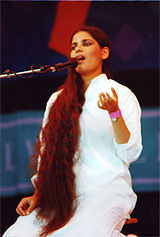 Sheila Chandra on stage.
Sheila Chandra on stage.
By the mid-1970s the demand among the relatively large Asian populations of many major British cities for familiar live music to entertain at weddings and other cultural occasions led to a flourishing Asian dance band scene, particularly Bhangra from the Punjab which supported bands like Alaap, formed in Southhall in London and Bhujhungy Group from Birmingham.[41]
Alaap's 1979 album Teri Chunni de Sitare for Multitone records, mixed traditional dhol and tumbi with synthesisers and electro beats and was a surprise hit to those outside of the scene. It opened the door for a flood of Asian recording artists in the UK including Apna Sangeet, Chirag Pehchan, Sangeeta and DCS.[41]
By the mid-1980s Bhangra was the most popular music among British Asians and a youth scene of daytime bhangra raves were a major part of a growing youth culture.[42] Multitone Records began to release remix albums, and bhangra picked up influences from hip hop and soul, producing groups like X-executive Sounds and Hustlers convention.
Other 1980s forms of British Indian music included the punk rock and rap of Aki Nawaz, the pop of Sheila Chandra, the hip hop of Joi Bangla and Osmani Sounds, and the ghazal/jazz fusion of Najma Akhtar.[41] The decade also saw the first record with clear south Asian influences since the 1960s to have an impact on the British charts, when Monsoon's "Ever so lonely" reached the top ten.[43]
Second British Invasion
Main article: Second British invasionThe Second British Invasion consisted of acts that came mainly out of the synthpop and New Romantic genres. These acts received exposure in the United States on the cable music channel MTV which launched in 1981. British artists, unlike many of their American counterparts, had learned how to use the music video early on.[44][45] Several British acts signed to independent labels were able to outmarket and outsell American artists that were signed with major labels. [45][46]
With considerable boost from MTV airplay during July 1982 The Human League's "Don't You Want Me" had a three week reign on top of the Billboard 100 chart, described by the Village Voice as the moment the Second British Invasion kicked off[47], they were followed by bands like Duran Duran whose glossy video's would come to symbolize the power of MTV.[45][48] In 1983 30% of the record sales were from British acts. 18 of the top 40 and 6 of the top 10 singles on July 18 were by British artists. Overall record sales rose by 10% from 1982.[45][49] Newsweek magazine featured Annie Lennox and Boy George on the cover of one of its issues while Rolling Stone Magazine would release an England Swings issue.[45] In April 1984 40 of the top 100 singles were from British acts while 8 of the top 10 singles in a May 1985 survey were of British origin.[50] In 1984 a majority of acts that signed to independent labels such as The Smiths were mining various rock influences becoming an alternative to the Second Invasion.[51] MTV continued its heavy rotation of videos by Second Invasion acts until 1987.[52]
Notes
- ^ S. Frith, Popular Music: The rock era (London, Routledge, 2004).
- ^ Rimmer, Dave. New Romantics: The Look (2003), Omnibus Press, ISBN 0711993963.
- ^ a b V. Bogdanov, C. Woodstra and S. T. Erlewine, All Music Guide to Rock: the Definitive Guide to Rock, Pop, and Soul (Milwaukee, WI: Backbeat Books, 3rd edn., 2002), ISBN 0-87930-653-X, pp. 1337-8.
- ^ Songs of The Free Bonus Tracks Allmusic review
- ^ Hard Allmusic review
- ^ a b R. Shuker, Popular music: the key concepts (Routledge, 2005), p. 128.
- ^ D. Hesmondhaigh, "Indie: the institutional political and aesthetics of a popular music genre" in Cultural Studies, 13 (2002), p. 46.
- ^ L. M. E. Goodlad and M. Bibby, eds, Goth: Undead Subculture (Duke University Press, 2007).
- ^ Hann, Michael (October 13, 2004). "Fey City Rollers". London: guardian.co.uk. http://arts.guardian.co.uk/features/story/0,11710,1325674,00.html. Retrieved November 12, 2006.
- ^ Hasted, Nick (October 27, 2006). "How an NME cassette launched indie music". London: independent.co.uk. http://enjoyment.independent.co.uk/music/news/article1932714.ece. Retrieved November 12, 2006.
- ^ "Genre – Shoegaze". Allmusic. http://www.allmusic.com/explore/style/d2680. Retrieved October 6, 2007.
- ^ "Genre – Madchester". Allmusic. http://www.allmusic.com/explore/style/d4391. Retrieved October 12, 2007.
- ^ I. Christe Sound of the Beast: The Complete Headbanging History of Heavy Metal (London: HarperCollins, 2003), ISBN 0380811278, p. 79.
- ^ D. Weinstein, Heavy Metal: The Music and its Culture (Cambridge MA: Da Capo, 2000), ISBN 0306809702, p. 21.
- ^ a b "Crustgrind," "Grindcore Special" part 2, p. 46
- ^ Felix von Havoc, Maximum Rock'n'Roll #198. [1] Archived by Havoc Records. Access date: June 20, 2008.
- ^ a b B. Sweers, Electric Folk: The Changing Face of English Traditional Music (Oxford University Press, 2005), pp. 197-8.
- ^ I. Peddie, The Resisting Muse: Popular Music and Social Protest (Aldershot: Ashgate, 2006), pp. 39-46.
- ^ a b c P. Gambaccini, T. Rice and J. Rice, British Hit Singles (6th edn., 1985), pp. 338-9.
- ^ K. Gelder, The subcultures reader (London: Routledge, 2005), p. 477.
- ^ a b c d P. Scaruffi, A History of Rock Music: 1951-2000 (iUniverse, 2003), pp. 234-5.
- ^ M. Silcott, Rave America: new school dancescapes (ECW Press, 1999), p. 47.
- ^ 80s Radiomusic.com - Record Mirror Hi-NRG charts
- ^ Chartstats.com - Hazell Dean "Searchin'"
- ^ Chartstats.com - Evelyn Thomas "High Energy"
- ^ Allmusic.com - Stock Aitken Waterman
- ^ A. Donnell, ed., Companion to contemporary Black British culture (London: Taylor & Francis, 2002), pp. 285-6.
- ^ a b c d G. Wald, "Soul's Revival: White Soul, Nostalgia and the Culturally Constructed Past, M. Guillory and R. C. Green, Soul: Black power, politics, and pleasure (New York University Press, 1997), pp. 139-58.
- ^ Hesmondhalgh, David. ""Urban Breakbeat Culture: Repercussions of Hip-Hop in the United Kingdom" in T. Mitchell, ed., Global Noise: Rap and Hip Hop Outside of the USA, (Middletown, CT: Wesleyan University Press), pp. 86-101.".
- ^ "Low Life/British hip hop, UK hip hop: the story". Archived from the original on 2006-10-10. http://web.archive.org/web/20061010071345/http://www.low-life.fsnet.co.uk/ukhiphop/story/early_doors.htm. Retrieved 2006-11-02.
- ^ "BBC News website, Massive Attack on the net". 1998-03-29. http://news.bbc.co.uk/1/hi/sci/tech/70844.stm. Retrieved 2006-11-02.
- ^ Fikentscher, Kai (July–August 2000). "Youth’s sonic forces: The club DJ: a brief history of a cultural icon". UNESCO Courier (UNESCO): 45.
- ^ J. Muncie, Youth and Crime (SAGE Publications Ltd, 2009), p. 221.
- ^ S. Redhead, The end of the century party: youth and pop towards 2000 (Manchester University Press, 1990), p. 112.
- ^ S. Reynolds, Generation ecstasy: into the world of techno and rave culture (London: Routledge, 1999), p. 1058.
- ^ a b c Jazz Britania, http://www.bbc.co.uk/bbcfour/music/features/jazz-brit3.shtml, retrieved 15/07/09.
- ^ Chilton, John. Who's Who of British Jazz. Continuum International Publishing Group. http://www.worldcat.org/search?qt=worldcat_org_all&q=0826472346.
- ^ N. Zuberi, Sounds English: Transnational Popular Music (University of Illinois Press, 2001), p. 188.
- ^ D. V. Moskowit, Caribbean popular music: an encyclopedia of reggae, mento, ska, rock steady, and dancehall (Greenwood Publishing Group, 2006), p. 270.
- ^ D. V. Moskowit, Caribbean popular music: an encyclopedia of reggae, mento, ska, rock steady, and dancehall (Greenwood Publishing Group, 2006), p. 306.
- ^ a b c S. Broughton, M. Ellingham, R. Trillo, O. Duane, and V. Dowell, World Music: The Rough Guide (London: Rough Guides, 1999), pp. 83-8.
- ^ S. Duncombem, Cultural Resistance Reader (Verso, 2002), p. 237.
- ^ G. Farrell, Indian music and the West (Oxford: Oxford University Press, 1999), pp. 209-10.
- ^ St. James encyclopedia of Pop Culture
- ^ a b c d e Rip It Up and Start Again Postpunk 1978-1984 by Simon Reynolds Pages 340,342-343
- ^ 1986 Knight Ridder news article
- ^ 100 & Single: The Dawning Of The MTV Era And How It Rocket-Fueled The Hot 100 Village Voice July 29, 2011
- ^ M. Haig, Brand Royalty: How the World's Top 100 Brands Thrive & Survive (Kogan Page Publishers, 2006), p. 54
- ^ OUP, retrieved 2007-11-05
- ^ "UK acts disappear from US charts", BBC News, http://news.bbc.co.uk/1/hi/entertainment/1946331.stm, retrieved 01/07/09.
- ^ Simon Reynolds, Rip It Up and Start Again Postpunk 1978–1984, pp. 392–393.
- ^ The Pop Life The New York Times June 15, 1988
See also
- 1980s in music
- Music of the United Kingdom (1950s)
- Music of the United Kingdom (1960s)
- Music of the United Kingdom (1970s)
- Music of the United Kingdom (1990s)
- Music of the United Kingdom (2000s)
Music of the United Kingdom Review by decade 
Popular contemporary genres Traditional genres British folk revival • Ballad • Carol • Children's song • Hornpipe • Jig • Morris dance • Protest song • Reel • Sea shanty • Strathspey • War song • Work songEthnic music Media and Performance Music awardsMusic chartsAlbums chart • Classical charts • Compilation chart • Dance chart • Download chart • Indie chart • R&B chart • Rock chart • Singles chart • Subscription plays chartMusic festivalsCambridge folk • Download • Edinburgh • Eisteddfodd • Glastonbury • Isle of Wight • Knebworth • Royal National Mod • The Proms • Reading and Leeds • T in the Park • VMusic mediaNational anthemRegional Music British IslesOverseasCategories:- British music history
- 1980s in music
Wikimedia Foundation. 2010.

